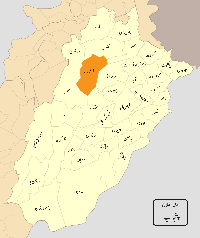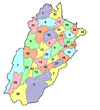Khushab District
| Khushab District ضِلع خُوشاب | |
|---|---|
| District | |
 | |
| Country | Pakistan |
| Province | Punjab |
| District Capital | Jauharabad |
| Established | July 01, 1982 [1] |
| Time zone | PST (UTC+5) |
| Number of Tehsils | 3 |
| Website | http://khushab.gop.pk/ |
Khushab District (Urdu: ضِلع خُوشاب) is a rural tribal district located in Punjab, Pakistan, with its headquarters at Jauharabad. It is named after the historical city of Khushab. According to the 1998 census, the population was 905,711 with 24.76% living in urban areas.[2] The district consists of three tehsils, Khushab, Noorpur Thal and Quaidabad and a Sub-Tehsil Naushehra [3] Khushab is home to the Heavy Water and Natural Uranium Research Reactor,[4] a critical part of the Pakistan's Special Weapons Program, which has come under much heated scrutiny.[5] Khushab is a combination of two Persian words: khush (Persian: خوش) meaning sweet or tasty and aab (Persian: آب) meaning water. A common belief is that the Persians, from the west, first used the word khush-aab in admiration of the sweet and tasty water found in the historical city situated on the bank of Jhelum River. With time the city started to be known as Khushab.[1]
Language
Inhabitants of Khushab District speak a great variety of Punjabi [6] dialects: which are
- Shapuri (Main dialect of the district)
- Majhi or standard (in cities)
- Pothohari (Northern Hilly Side),
- Thalochi (southern areas near bhakar)
- Jandali (western areas near Mianwali).
Urdu being national language is spoken and understood by most of the population.
English is also understood and spoken by the educated elite.
History
Khushab District was an agricultural region with forests during the Indus Valley Civilization. The Vedic period is characterized by Indo-Aryan culture that invaded from Central Asia and settled in Punjab region. The Kambojas, Daradas, Kaikayas, Madras, Pauravas, Yaudheyas, Malavas, Saindhavas and Kurus invaded, settled and ruled ancient Punjab region. After overrunning the Achaemenid Empire in 331 BCE, Alexander marched into present-day Punjab region with an army of 50,000. The Khushab was ruled by Maurya Empire, Indo-Greek kingdom, Kushan Empire, Gupta Empire, White Huns, Kushano-Hephthalites and Shahi kingdoms.
In 997 CE, Sultan Mahmud Ghaznavi, took over the Ghaznavid dynasty empire established by his father, Sultan Sebuktegin. In 1005 he conquered the Shahis in Kabul in 1005, and followed it by the conquests of Punjab region. The Delhi Sultanate and later Mughal Empire ruled the region. The Punjab region became predominantly Muslim due to missionary Sufi saints whose dargahs dot the landscape of Punjab region. After the decline of the Mughal Empire, the Sikh invaded and occupied Khushab District. The Muslims faced severe restrictions during the Sikh rule. During the period of British rule, Khushab district increased in population and importance.
The predominantly Muslim population supported Muslim League and Pakistan Movement. After the independence of Pakistan in 1947, the minority Hindus and Sikhs migrated to India while the Muslim refugees from India settled in the Khushab District.
Notable residents
- Ahmed Nadeem Qasmi, Urdu poet, fiction writer and journalist
- Wasif Ali Wasif, teacher, writer, poet, and Sufi
Nuclear installations
On March 21, 2000, the Christian Science Monitor published an article written by Alexander Colhoun, a high-resolution aerial satellite photo revealed a nuclear reactor and a missile base near the city of Khushab (32°1′12.62″N 72°12′27.02″E / 32.0201722°N 72.2075056°E). These pictures had mixed views, one of the expression of power that could shackle or reshape diplomatic landscapes[7] of a region and another of the ethical question about the usage of satellite imagery in terms of privacy and national sovereignty of a nuclear-capable nation. The report was published at a time when American President Bill Clinton was due to visit India and sparked concerns worldwide. It was later clearly stated in the Dawn newspaper on June 14, 2000, that this particular nuclear reactor at Khushab and its reprocessing plant were generating between 8 to 10 kilograms of weapons-grade plutonium per year, dedicated for military use.
Geography
Khushab is situated between the cities of Sargodha and Mianwali, near the river Jhelum. The district headquarters is located at Jauharabad (founded 1953, pop. 39,477).
Khushab consists of agricultural lowland plains, lakes, and hills. Parts of the Thal desert touch the district, which has a breadth of over 70 miles (110 km) and is situated between the Indus river and the Jhelum river. The district is rich in natural resources (salt and coal). Most people are associated with farming and agriculture. In the 1980s the district was classified as a tax-relief zone for new industries. This led to the establishment of many industries including cement, sugar, and textiles.
There are three lakes (Ochali, Khabbaki and Sodhi Jay Wali) in the district. Garden Kanhatti Garden near Khabbaki village is located in the Soon valley area, which is the largest forest in Khushab district. Katha Saghral area is semi-hilly and mineral area, noted for its coal and salt mining. Khabikki Lake is a salt-water lake in the southern Salt Range area in Pakistan. The lake is one kilometre wide and two kilometres long. Khabikki is also the name of a neighbouring village. Sakaser is the highest mountain in the Salt Range area in Pothohar in Pakistan. It is 1522 metre / 4946 feet high. It is situated in Khushab District but it can be seen from adjoining districts of Mianwali and Chakwal. Ochali or Uchhali Lake is just below the Sakaser mountain, it is a salt-water lake in the southern Salt Range area in Pakistan. Sakaser (1522 metre / 4946 feet), the highest mountain in the Salt Range, looms over the lake. Due to its brackish water the lake is lifeless.
People and Culture
Most of the people belong to the Tribal and villager life style. Most important Tribes of the areas are Hashmi Sadat-Descendants of Bahauddin Zakariyya Multani(Syeds of Pail-Piran), Awan, Sangha - [MALIKS], Tiwana, Lila (Malike), Naichs (Malik), Baghoor, Parachas, Belals (Malik), Syeds (Hamdanis), Baloachs, Janjauas, Mangat, Bandials, Utras,kohlar(malik) Saggus, Chheenas, Sheikh, Maikens, Joyia (Malik), Rahdaris, Jasras, Waghras, Kharas, Doodhas, Baggahs, Kalus, Boranas, Doohns, Majoka (Malik) etc. and most important villages are Villages of Khushab tehsil are Kund, Hadali, Daiwal(the hub of the Sanghas), Mitha Tiwana, Hassan Pur Tiwana (Hamoka), Bola, Roda, Parachagan, Jalalpur Syedan Hamdania, Mohib-Pur, Girot, Nali Nari, Khatha, Padhrar Dhak, Khhotakka, Bansi, Balwal, Pail-Piran,Jaba, Khabeki, Mardwal, Nowshera, Anga and Kufri. Villages in Tehsil Noor Pur Thal are Noor Pur, Adhi Sargil, Adhi Kot, Chan, Rangpur Baghoor, Jamali, Rahdari, Mehmood Shaheed, Shahwala, Shah Hussain, Boranawala, Palowan, Kalwal, Sidha, Maiken, Bambool, Jara, Jharkil, Nawan Saggu, Dhamak, Nikro Shaheed, Katimar, Obhal, Khai Majoka, Jatooi, Billand and Pelovanis. Villages in Tehsil Quaidabad are Choa, Warchcha, Okhali Mohla, Gunjayal, Mitha Kho, Bandiyal, Jabbi Sharif (the main Village of Daman Mohar), 14MB, Goleywali and Namewali, Majoka etc.
Administration
The district is divided into three tehsils, Khushab, Noorpur Thal, and Quaidabad and a Sub-Tehsil Naushehra,[3] where the latter was created in March 2007.[8] Previous to the creation of the Quaidabad tehsil, it contained a total of fifty-one Union Councils.[9]
Khushab tehsil
Khushab is subdivided into 32 Union Councils.:[8][9]
|
|
Noorpur Thal tehsil
Noorpur Thal is subdivided into 10 Union Councils.[9]
Quaidabad tehsil
Quaidabad is subdivided into 9 Union Councils.[8]
- Bandial Janubi
- Bijar
- Chak No.14/Mb
- Goleywali
- Gunjial Janubi
- Okhali Mohlah
- Quaidabad
- Utra Janubi
- Warcha
Political Back Grounds
Politically the District Khushab has a vital backgrounds. Tiwana, Awan and Aheer families are most famous in this field of the life. The Political leaders of the district are Malik Naeem Khan Awan:-Ex Federal Minister, Malik KhudaBuksh Tiwana Ex Provincial Minister, Malik Shakir Bashir Awan -A young political leader- MNA NA -70, Miss Sumaira Malik MNA NA-69, Malik Umar Aslam Awan:-Ex-MNA, Malik Saif Ullah Tiwana:-Ex-MNA, Mailik Muhammad Asif Bha MPA PP-41 Provincial Minister for Forest, Malik Karam Ellahi Bandial MPA PP-40, Malik Muhammad Waris Kallu MPA PP-42, Malik Javid Iqbal Awan MPA PP-39, Capt. Dr. Muhammad Rafiq Ex-MPA, Malik Muhammad Azam Advocat Ex-MPA, Malik Saleh Muhammad Gunjial:- Ex MPA, Malik Khuda Baksh Wadhal:-Ex MPA, Malik Ghulam Muhammad Tiwana :-District Nazim, Malik Ehsan Ullah Tiwana:- Ex - District Nazim, Malik Ameer Mukhtar Sangha Awan:- Ex Chairman, Malik Atta Ullah Gunjial:- Naib Zila Nazim, Malik Ghulam Rasool Sangha Awan:- Tehsil Nazim Khushab, Malik Ayub Bha, Ex- Tehsil Nazim Khushab, Malik Said Rasool Salhal:- Tehsil Nazim, Noorpur Thal, Muhammad Yar:- Naib Tehsil Nazim Khushab, Muhammad Khan Borana:- Naib Tehsil Nazim, Noorpur Thal and Malik Tahir Raza Baghoor :Ex Naib Tehsil Nazim Noorpur Thal
References
- ↑ 1.0 1.1 "District Courts Khushab"., Retrieved 24 December 2013.
- ↑ Urban Resource Centre (1998 Census)
- ↑ 3.0 3.1 "Tehsil Codes" (PDF).
- ↑ Special Weapons Program of Pakistan (Federation of American Scientists)
- ↑ South Asia arms race - is it paranoia? (BBC News).
- ↑ http://www.findpk.com/cities/Explorer-pakistan-Khushab.html
- ↑ Top-Secret Kodak Moment In Space Shakes Global Security, Christian Science Monitor (March 21, 2000).
- ↑ 8.0 8.1 8.2 "Tehsil status -DAWN - National; March 24, 2007". archives.dawn.com. Retrieved 27 January 2012.
- ↑ 9.0 9.1 9.2 Tehsils & Unions in the District of Khushab - Government of Pakistan
http://khushab.gop.pk/html/About_District.html#About_District_Intro
External links
| ||||||||||||||||
| |||||||||||||||||||||||||||||||||||||||||||||||||||||||||||||||||||||||||||||||||||||||||||||||||||||||||||||||||||||||||||||||||

